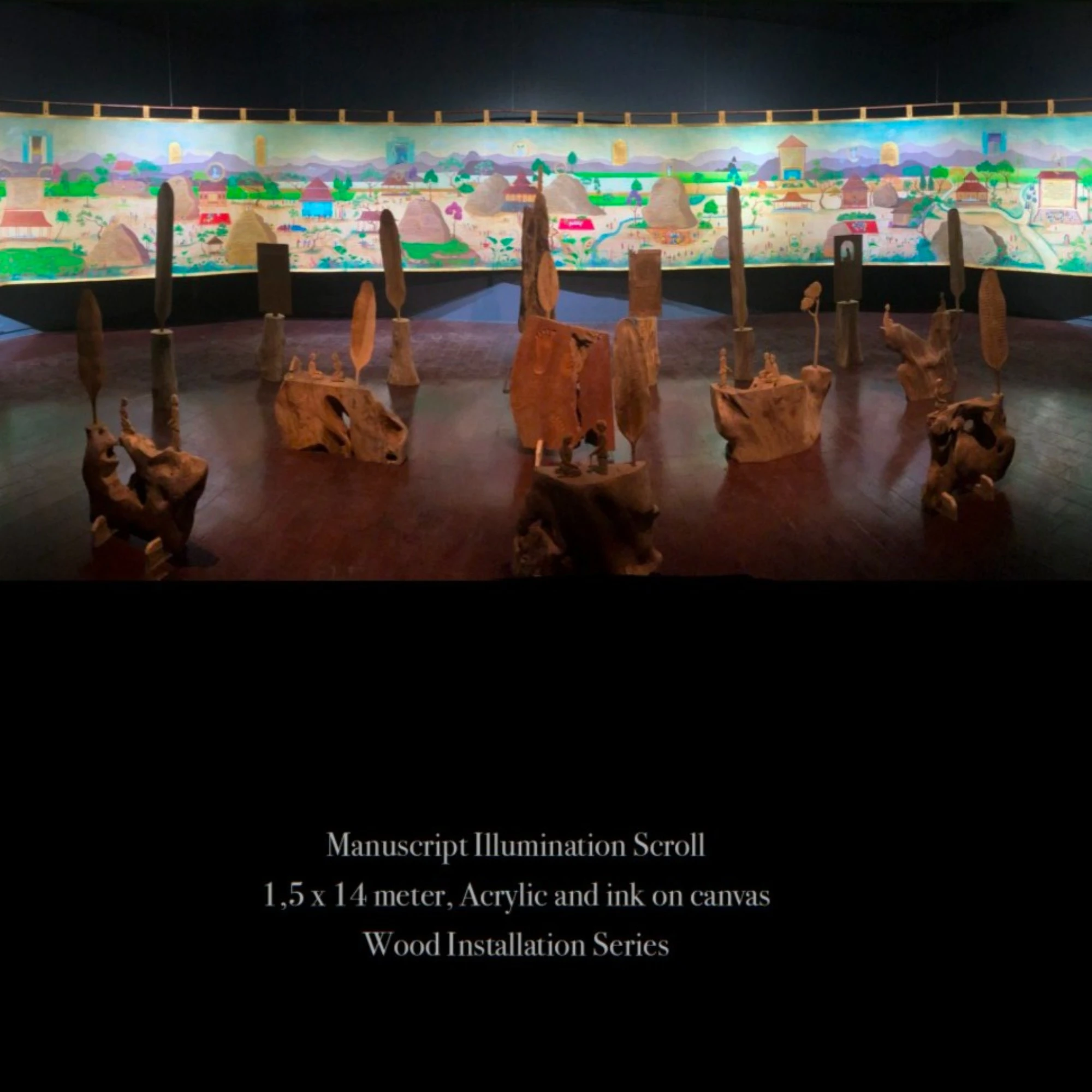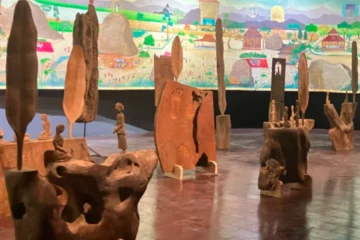Taking a closer look at Cosmic Egg and exploring the layers of work presented by Faisal Kamandobat at ArtJog 2025 offers a refreshing experience in appreciating art. Cosmic Egg invites us on an adventure into another realm, an imaginary world filled with narratives and characters. Within this, Faisal weaves in elements of fictional autobiography or autobiografiction, enriching the experience even further.
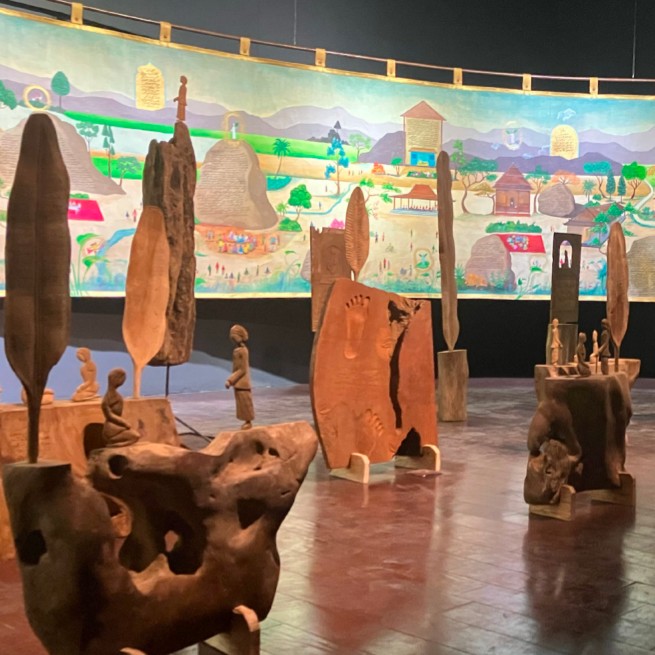
Imagine encountering a piece of art that doesn’t just exist within the confines of an exhibition space, leaving you to ponder its meaning. Instead, you feel as if you’re being drawn into an imaginary world as you gaze upon the work. How is this possible? It’s because the artist presents a clear narrative that guides us through the unfolding layers of the artwork.
A 14 meter long and 1.5 meter wide canvas, inscribed in the Arabic Pegon script, was displayed in the exhibition space during ArtJog 2025, themed Motif: Amalan. This exhibition took place at the Jogja National Museum in mid 2025. Alongside the paintings, there were also wooden sculptures, wayang figures, and traditional blackboards on display.
The full title of the work is Cosmic Egg: The Prophetic Letters of Kiai Jembar Manah. Created by Faisal Kamandobat, an artist from Cilacap, Central Java, this multidimensional installation serves as a book of knowledge that transcends mere visual beauty, uniting spiritual, cosmological, ecological, and social experiences.
In short, Faisal offers a comprehensive package filled with universal knowledge. He refers to this as a medium of illuminated manuscripts, blending Arabic Pegon script, symbolic figures, carvings, and performative elements. Thus, Faisal provides not only aesthetic beauty but also philosophical aspects within Cosmic Egg.
One intriguing element of this work is the presence of a fictional character in the narrative: Kiai Jembar Manah. If you look closely, you’ll see that Kiai Jembar Manah is not only a fictional figure but also a representative of Faisal himself and his father.
In philosophical terms, what Faisal is doing can be described as fictional autobiography or autobiografiction, a concept introduced by Stephen Reynolds in 1906 and further developed by Max Saunders in 2010.
In this essay, I aim to discuss Cosmic Egg: The Prophetic Letters of Kiai Jembar Manah by Faisal Kamandobat from the perspective of a fictional autobiography, using the analytical frameworks of Reynolds and Saunders.
Stay tuned, as I will also write another piece examining Faisal’s work through the lenses of ecology and tradition. So, there will be two essays delving into Cosmic Egg!
Autobiografiction or Fictional Autobiography
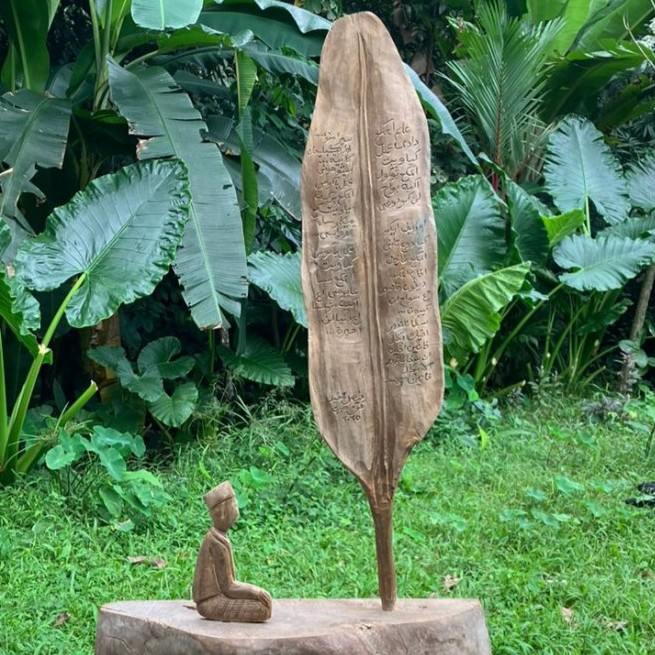
As previously mentioned, Cosmic Egg: The Prophetic Letters of Kiai Jembar Manah is Faisal’s way of presenting an autobiography through art. I had the opportunity to confirm this suspicion directly with Faisal over the phone. “Yes, it’s my autobiography along with my father’s. That’s why it’s called a fictional autobiography with the character Kiai Jembar Manah. Hehehe,” he shared with me on September 8, 2025.
The figure of his father, who grew up and contributed to the development of Majenang, has left a profound impact on Faisal. This is evident in his father’s legacy of building and preserving the Pondok Pesantren Pembangunan Miftahul Huda, or Islamic Boarding School Cigaru, in Majenang, Cilacap, Central Java.
Faisal’s love and respect for his father are intricately woven together, giving rise to the character of Kiai Jembar Manah, a fictional figure representing a local scholar living among the community in Karanggedang, Majenang.
It’s no surprise that the narrative Faisal presents is set in his own village, featuring local figures such as students, farmers, carpenters, merchants, and others. These characters navigate the challenges of modernity while preserving their religious, cultural, and social traditions.
Thus, Cosmic Egg can be enjoyed like reading a book, watching a film, or observing a wayang performance. Faisal creates an imaginative space for us, offering a narrative rich with possibilities for interpretation based on our perceptions while engaging with Cosmic Egg. In fact, Faisal has stated that the work is open to reinterpretation by anyone willing to refresh the narrative he has crafted.
For Faisal, communities that are less exposed to government policies and globalization are often quicker to rise from adversity. He cites the Bajo tribe, who remain distant from the spotlight, as an example of a group that demonstrates resilience in the face of change.
“Because those communities can be resilient and develop according to the structures they create themselves. And those structures are formed holistically, unlike government initiatives,” he remarked.
“Yes, it’s my autobiography along with my father’s. That’s why it’s called Fictional Autobiography,” Faisal Kamandobat confirmed when I contacted him on September 8, 2025.
Between Stephen Reynolds and Max Saunders
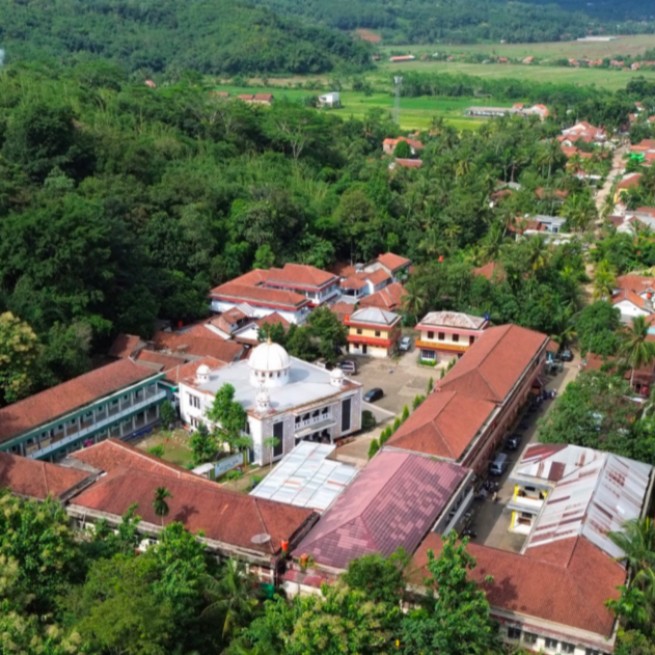
Stephen Reynolds first introduced the term autobiografiction in his book Autobiografiction (1906). He described a form of writing that exists between autobiography, fiction, and essay. Reynolds referred to such works as “a record of real spiritual experiences strung on a credible but more or less fictitious autobiographical narrative” (Reynolds, 1906, p. 3). This means that a text can originate from the author’s real experiences but is retold within a framework of fictional or imaginative narrative.
It’s no surprise that Faisal Kamandobat’s Cosmic Egg fits into the category of autobiografiction. His work captures spiritual and personal experiences, conveyed through the medium of cosmic symbols and the imaginary figure of Kiai Jembar Manah. The author describes this work as a fictionalized autobiography, emphasizing its narrative.
Furthermore, Cosmic Egg can also be viewed through the lens of Max Saunders. In his book Self Impression: Life-Writing, Autobiografiction, and the Forms of Modern Literature (2010), Saunders asserts that autobiografiction is a modernist strategy for writing life that blurs the boundaries between factual autobiography and imaginary narrative. He writes, “Autobiografiction is life-writing which presents itself as fictional, but which at the same time invokes the autobiographical pact” (Saunders, 2010, p. 8).
This category allows Faisal to document personal experiences while processing them within a structure of symbols and fictional narratives. Thus, Cosmic Egg can be understood as a work that intertwines the autobiographies of Faisal and his father, yet is retold in the form of cosmic fiction that embraces the symbol of the egg and the imaginary figure of Kiai Jembar Manah.
In Cosmic Egg, Faisal not only expresses himself but also allows the imaginary character (Kiai Jembar Manah) to function as a transcendent medium that encompasses the experiences of both his father and himself, the traditions of the Islamic boarding school, and the cosmic horizon of his life in Cigaru.
According to Saunders, such practices create a new form of self-writing that “tests the boundaries between authenticity and fiction” (p. 15). While conventional autobiography emphasizes the authenticity of life stories, autobiografiction showcases the ambivalence between fact and imagination as its strength.
Cosmic Egg can be viewed through this framework, where the work does not pretend to be a factual account of Faisal and his father’s biographies, but rather a symbolic construction that reveals essential truths in the form of cosmic fiction. In other words, the truth here is not factual truth, but the truth of inner experiences formulated through symbols.
This is Clearly an Autobiografiction!
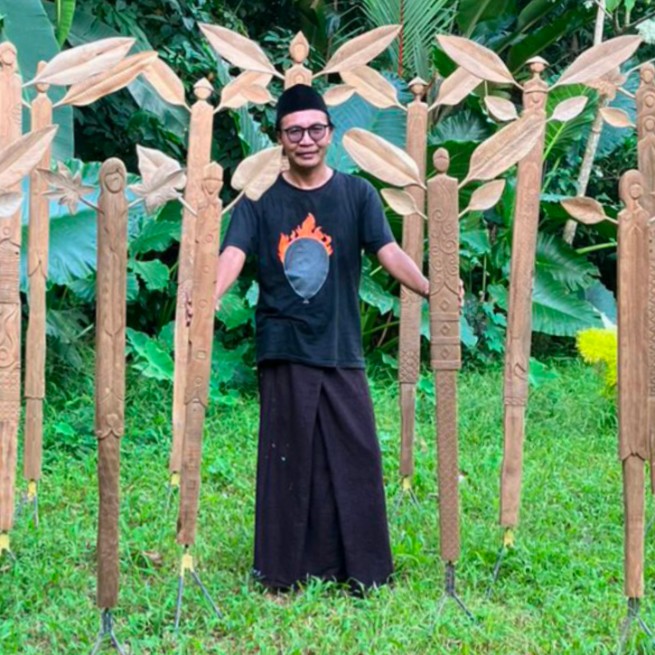
Ultimately, reading Cosmic Egg through Saunders’ lens allows us to place the work within the long tradition of autobiografiction, a practice in art and literature that recognizes the limitations of pure autobiography and embraces fiction and symbols as deeper means to unveil personal experiences.
Faisal consciously writes himself and his father as a symbolic fictional narrative, affirming what Saunders describes as “the modernist experiment in life writing” (p. 19), which seeks to present life not as linear documentation but as a rich narrative and symbolic play.
While Reynolds, through the concept of autobiografiction, asserts that autobiography can be constructed from real experiences told within a fictional framework, Saunders expands this framework by highlighting the performative and role-playing dimensions in Self Impression.
In the context of Cosmic Egg, Faisal’s work can be understood as a harmonious meeting of these two ideas, where he borrows the real experiences of himself and his father as described by Reynolds, while also channeling that identity through the symbolic persona of Kiai Jembar Manah, as emphasized by Saunders.
Thus, Faisal’s work functions as a fictional biography or autobiografiction that not only records life in fictional form but also presents it as a cosmic role-playing game that connects personal autobiography with broader symbols and meanings.
- Cover image: Photo courtesy on The ArtJog 2025 catalog.

